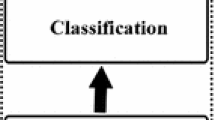Abstract
In this paper, we present an enhanced fuzzy k-nearest neighbor (FKNN) classifier based computer aided diagnostic (CAD) system for thyroid disease. The neighborhood size k and the fuzzy strength parameter m in FKNN classifier are adaptively specified by the particle swarm optimization (PSO) approach. The adaptive control parameters including time-varying acceleration coefficients (TVAC) and time-varying inertia weight (TVIW) are employed to efficiently control the local and global search ability of PSO algorithm. In addition, we have validated the effectiveness of the principle component analysis (PCA) in constructing a more discriminative subspace for classification. The effectiveness of the resultant CAD system, termed as PCA-PSO-FKNN, has been rigorously evaluated against the thyroid disease dataset, which is commonly used among researchers who use machine learning methods for thyroid disease diagnosis. Compared to the existing methods in previous studies, the proposed system has achieved the highest classification accuracy reported so far via 10-fold cross-validation (CV) analysis, with the mean accuracy of 98.82% and with the maximum accuracy of 99.09%. Promisingly, the proposed CAD system might serve as a new candidate of powerful tools for diagnosing thyroid disease with excellent performance.



Similar content being viewed by others
Notes
http://www.clevelandclinic.org/health/health-info/docs/2000/2011.asp, last accessed November 23, 2011.
References
Ozyilmaz, L., and Yildirim, T., Diagnosis of thyroid disease using artificial neural network methods. In Proceedings of ICONIP’02 nineth international conference on neural information processing, Orchid Country Club, Singapore (pp. 2033–2036), 2002.
Serpen, G., Jiang, H., and Allred, L., Performance analysis of probabilistic potential function neural network classifier. In Proceedings of artificial neural networks in engineering conference, St. Louis, MO, (Vol. 7, pp. 471–476), 1997.
Pasi, L., Similarity classifier applied to medical data sets, 2004, 10 sivua, Fuzziness in Finland’04. In International conference on soft computing, Helsinki, Finland & Gulf of Finland & Tallinn, Estonia, 2004.
Polat, K., Sahan, S., and Gunes, S., A novel hybrid method based on artificial immune recognition system (AIRS) with fuzzy weighted pre-processing for thyroid disease diagnosis. Expert Syst. Appl. 32(4):1141–1147, 2007.
Keles, A., and Keles, A., ESTDD: Expert system for thyroid diseases diagnosis. Expert Syst. Appl. 34(1):242–246, 2008.
Temurtas, F., A comparative study on thyroid disease diagnosis using neural networks. Expert Syst. Appl. 36(1):944–949, 2009.
Dogantekin, E., Dogantekin, A., and Avci, D., An expert system based on generalized discriminant analysis and wavelet support vector machine for diagnosis of thyroid diseases. Expert Syst. Appl. 38(1):146–150, 2011.
Chen, H. L., Yang, B., et al., A three-stage expert system based on support vector machines for thyroid disease diagnosis. J Med Syst: http://dx.doi.org/10.1007/s10916-011-9655-8,2011.
Sim, J., Kim, S. Y., et al., Prediction of protein solvent accessibility using fuzzy k-nearest neighbor method. Bioinformatics 21(12):2844–2849, 2005.
Huang, Y., and Li, Y., Prediction of protein subcellular locations using fuzzy k-NN method. Bioinformatics 20(1):21–28, 2004.
Shen, H. B., Yang, J., et al., Fuzzy KNN for predicting membrane protein types from pseudo-amino acid composition. J. Theor. Biol. 240(1):9–13, 2006.
Ghazavi, S. N., and Liao, T. W., Medical data mining by fuzzy modeling with selected features. Artif. Intell. Med. 43(3):195–206, 2008.
Seker, H., Odetayo, M. O., et al., A fuzzy logic based-method for prognostic decision making in breast and prostate cancers. IEEE Trans. Inf. Technol. Biomed. 7(2):114–122, 2003.
Yu, S., De Backer, S., et al., Genetic feature selection combined with composite fuzzy nearest neighbor classifiers for hyperspectral satellite imagery. Pattern Recogn. Lett. 23(1–3):183–190, 2002.
Chen, H.-L., Liu, D.-Y., et al., An adaptive Fuzzy k -nearest neighbor method based on parallel particle swarm optimization for bankruptcy prediction. Advances in knowledge discovery and data mining. J. Huang, L. Cao and J. Srivastava, Springer Berlin / Heidelberg. 6634:249–264, 2011.
Chen, H. L., Yang, B., et al., A novel bankruptcy prediction model based on an adaptive fuzzy k-nearest neighbor method. Knowl. Base. Syst. 24(8):1348–1359, 2011.
Keller, J. M., A fuzzy k-nearest neighbor algorithm. IEEE Trans. Syst. Man Cybern. 15(4):581, 1985.
Eberhart, R. C., and Kennedy, J., A new optimizer using particle swarm theory. In: Sixth international symposium on micro machine and human science, Nagoya, pp 39–43. 1995.
Kennedy, J., and Eberhart, R. C., Particle swarm optimization. In: Proceedings of the IEEE International Conference on Neural Network, vol. 4, 1995, pp. 1942–1948. 1995.
Shi, Y., and Eberhart, R., A modified particle swarm optimizer. In Proceedings of the IEEE international conference on evolutionary computation, IEEE Press, Piscataway, NJ (1998) p. 69–73, 1998.
Ratnaweera, A., Halgamuge, S., and Watson, H., Self-organizing hierarchical particle swarm optimizer with time-varying acceleration coefficients. EEE Trans. Evol. Comput. 8(3):240–255, 2004.
Kohavi, R., A study of cross-validation and bootstrap for accuracy estimation and model selection. In: Mellish, C. S. (Ed.), Proceedings IJCAI-95 Montreal, Que. Morgan Kaufmann, Los Altos, CA, pp. 1137–1143, 1995.
Chen, H. L., Liu, D. Y., et al., A new hybrid method based on local fisher discriminant analysis and support vector machines for hepatitis disease diagnosis. Expert Syst. Appl. 38(9):11796–11803, 2011.
Chen, H. L., Yang, B., et al., A support vector machine classifier with rough set-based feature selection for breast cancer diagnosis. Expert Syst. Appl. 38(7):9014–9022, 2011.
Polat, K., and Gunes, S., Computer aided medical diagnosis system based on principal component analysis and artificial immune recognition system classifier algorithm. Expert Syst. Appl. 34(1):773–779, 2008.
Polat, K., and Gunes, S., An expert system approach based on principal component analysis and adaptive neuro-fuzzy inference system to diagnosis of diabetes disease. Digit. Signal Process. 17(4):702–710, 2007.
Duda, R. O., Hart, P. E., and Stork, D. G., Pattern classification. 2001. Wiley, New York, 2001.
Acknowledgements
This research is supported by the National Natural Science Foundation of China (NSFC) under Grant Nos. 60873149, 60973088, 60773099. This work is also supported by the Open Projects of Shanghai Key Laboratory of Intelligent Information Processing in Fudan University under the Grant No. IIPL-09-007.
Author information
Authors and Affiliations
Corresponding author
Rights and permissions
About this article
Cite this article
Liu, DY., Chen, HL., Yang, B. et al. Design of an Enhanced Fuzzy k-nearest Neighbor Classifier Based Computer Aided Diagnostic System for Thyroid Disease. J Med Syst 36, 3243–3254 (2012). https://doi.org/10.1007/s10916-011-9815-x
Received:
Accepted:
Published:
Issue Date:
DOI: https://doi.org/10.1007/s10916-011-9815-x




